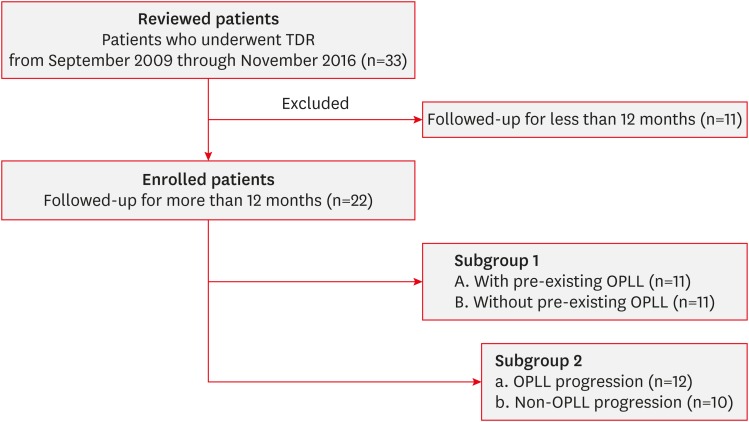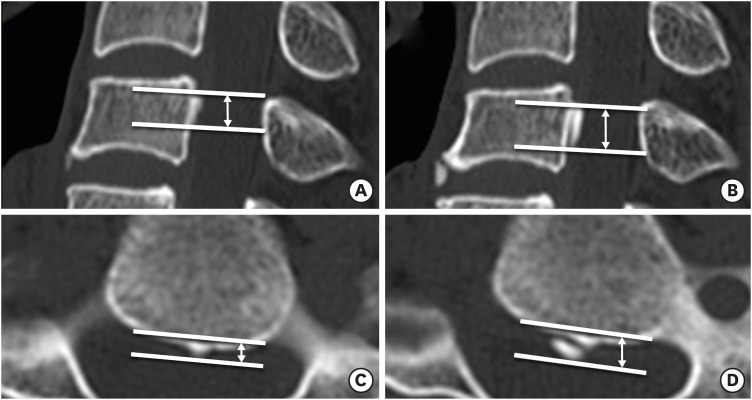Korean J Neurotrauma.
2019 Oct;15(2):135-142. 10.13004/kjnt.2019.15.e28.
Progression of Ossification of the Posterior Longitudinal Ligament after Cervical Total Disc Replacement
- Affiliations
-
- 1Department of Neurosurgery, The Armed Forces Capital Hospital, Seongnam, Korea. arch73@gmail.com
- KMID: 2461118
- DOI: http://doi.org/10.13004/kjnt.2019.15.e28
Abstract
OBJECTIVE
Total disc replacement (TDR) is frequently performed anterior approaching method for the patients diagnosed with cervical disc herniation. This study aimed to assess the degree of ossification of the posterior longitudinal ligament (OPLL) progression after cervical TDR.
METHODS
Twenty-two male soldiers who underwent cervical TDR surgery from 2009 to 2016 and were followed-up for more than 12 months were enrolled. The enrolled patients were classified as; 1) patients with pre-existing OPLL and without; and 2) patient showing progression of OPLL or not.
RESULTS
Twenty-two men were included in the analysis. The mean follow-up period from the surgery was 41.4 months (range, 12-114 months). The mean age of all patients was 40.7 years (range, 31-52 years). TDR-only was used in 7 cases, and the hybrid surgery (TDR+ACDF) was used in 15 cases. The incidence of progression or newly development of OPLL was significantly higher in pre-existing OPLL group (p=0.01). In 11 cases showing the progression of the OPLL, the mean size of OPLL progression was 4.16 mm (range, 0.34-18.87 mm) in the longitudinal height and 1.57 mm (range, 0.54-3.91 mm) in thickness.
CONCLUSION
The progression of OPLL after cervical TDR was more frequent in patients with pre-existing OPLL than in patients without OPLL. Even though TDR is a major alternative to the treatment of cervical lesions to preserve vertebral segmental motion, careful attention should be paid to whether TDR should be used in patients with OPLL and this should be fully explained to the patient.
Keyword
MeSH Terms
Figure
Reference
-
1. Chiba K, Yamamoto I, Hirabayashi H, Iwasaki M, Goto H, Yonenobu K, et al. Multicenter study investigating the postoperative progression of ossification of the posterior longitudinal ligament in the cervical spine: a new computer-assisted measurement. J Neurosurg Spine. 2005; 3:17–23. PMID: 16122017.
Article2. Cho HJ, Shin MH, Huh JW, Ryu KS, Park CK. Heterotopic ossification following cervical total disc replacement: iatrogenic or constitutional? Korean J Spine. 2012; 9:209–214. PMID: 25983817.
Article3. Choi BW, Baek DH, Sheffler LC, Chang H. Analysis of progression of cervical OPLL using computerized tomography: typical sign of maturation of OPLL mass. J Neurosurg Spine. 2015; 23:539–543. PMID: 26186351.
Article4. Hirabayashi K, Miyakawa J, Satomi K, Maruyama T, Wakano K. Operative results and postoperative progression of ossification among patients with ossification of cervical posterior longitudinal ligament. Spine (Phila Pa 1976). 1981; 6:354–364. PMID: 6792717.
Article5. Hori T, Kawaguchi Y, Kimura T. How does the ossification area of the posterior longitudinal ligament progress after cervical laminoplasty? Spine (Phila Pa 1976). 2006; 31:2807–2812. PMID: 17108834.
Article6. Hori T, Kawaguchi Y, Kimura T. How does the ossification area of the posterior longitudinal ligament thicken following cervical laminoplasty? Spine (Phila Pa 1976). 2007; 32:E551–E556. PMID: 17762797.
Article7. Kawaguchi Y, Furushima K, Sugimori K, Inoue I, Kimura T. Association between polymorphism of the transforming growth factor-beta1 gene with the radiologic characteristic and ossification of the posterior longitudinal ligament. Spine (Phila Pa 1976). 2003; 28:1424–1426. PMID: 12838101.8. Lee CH, Jahng TA, Hyun SJ, Kim KJ, Kim HJ. Expansive laminoplasty versus laminectomy alone versus laminectomy and fusion for cervical ossification of the posterior longitudinal ligament: Is there a difference in the clinical outcome and sagittal alignment? Clin Spine Surg. 2016; 29:E9–E15. PMID: 25075990.9. Lee SE, Chung CK, Jahng TA. Early development and progression of heterotopic ossification in cervical total disc replacement. J Neurosurg Spine. 2012; 16:31–36. PMID: 21999390.
Article10. Matsunaga S, Sakou T, Taketomi E, Yamaguchi M, Okano T. The natural course of myelopathy caused by ossification of the posterior longitudinal ligament in the cervical spine. Clin Orthop Relat Res. 1994; 168–177.
Article11. Morisu M. Influence of foods on the posterior longitudinal ligament of the cervical spine and serum sex hormones. Nippon Seikeigeka Gakkai Zasshi. 1994; 68:1056–1067. PMID: 7876685.12. Shin J, Kim YW, Lee SG, Park EC, Yoon SY. Cohort study of cervical ossification of posterior longitudinal ligament in a Korean populations: demographics of prevalence, surgical treatment, and disability. Clin Neurol Neurosurg. 2018; 166:4–9. PMID: 29353222.
Article13. Sohn S, Chung CK, Yun TJ, Sohn CH. Epidemiological survey of ossification of the posterior longitudinal ligament in an adult Korean population: three-dimensional computed tomographic observation of 3,240 cases. Calcif Tissue Int. 2014; 94:613–620. PMID: 24658710.
Article14. Takatsu T, Ishida Y, Suzuki K, Inoue H. Radiological study of cervical ossification of the posterior longitudinal ligament. J Spinal Disord. 1999; 12:271–273. PMID: 10382784.
Article15. Tsuyama N. Ossification of the posterior longitudinal ligament of the spine. Clin Orthop Relat Res. 1984; 71–84.
Article
- Full Text Links
- Actions
-
Cited
- CITED
-
- Close
- Share
- Similar articles
-
- Ossification of the Posterior Longitudinal Ligament: 2 cases report
- Does Ossification of the Posterior Longitudinal Ligament Progress after Fusion?
- Dysphagia Caused by Ossification of the Cervical Anterior Longitudinal Ligament
- Treatment of Ossification of Posterior Longitudinal Ligament in Cervical Spine with Anterior Fusion and Anterior Decompression: Report of 3 Cases
- A Case Quadriplegia due to Minor Head Trauma Associated with Ossification of the Posterior Longitudinal Ligament of the Cervical Spine




